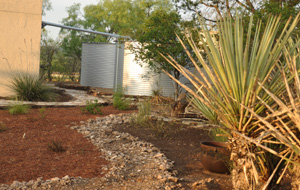Rainwater Harvesting
Rainwater Harvesting
helping people create sustainable water supplies

Be a Catalyst…
Nowadays, people open the valve to the kitchen faucet and don’t think twice… but what will happen when nothing comes out? It is estimated that between the years 2020 and 2030 the Ogallala Aquifer will run dry. This isn’t an issue to push on to future generations. Water is the basis of all life, and once it is gone, it’s gone. There are many steps each of us can take to be the catalyst for change we all inevitably need.
Getting Water Smart...

Water will be the most critical resource issue of our lifetime. The first step in becoming a catalyst lies in the understanding of your local ecosystem. Knowing your system potential is the foremost factor in determining how to create a sustainable rainwater harvesting site. Historical rainfall data, evapo-transpiration rates, geographical location, and catchment area, among many other things, are important pieces of data in deciding if rainwater harvesting is appropriate for you.

The importance of understanding your local ecosystem will help you minimize your water dependence by the greatest amount. Approximately 70% of a households water use is in the landscape. Switching from St. Augustine to native turf can save you as much as 2,000 gallons per month for every 1,000 square feet of lawn. When sizing a rainwater harvesting system, it is best to plan for the long term and worst case scenario to the fullest extent within your means. It is much more cost effective to install the system right the first time than making upgrades and repairs along the way. Especially on new construction projects, consider installing greywater re-use systems and increasing your roof catchment area for any additional uses of water in the future.

When sizing a rainwater harvesting system, it is best to plan for the long term and worst case scenario to the fullest extent within your means. It is much more cost effective to install the system right the first time than making upgrades and repairs along the way. Especially on new construction projects, consider installing greywater re-use systems and increasing your roof catchment area for any additional uses of water in the future.When sizing a rainwater harvesting system, it is best to plan for the long term and worst case scenario to the fullest extent within your means. It is much more cost effective to install the system right the first time than making upgrades and repairs along the way. Especially on new construction projects, consider installing greywater re-use systems and increasing your roof catchment area for any additional uses of water in the future.
The Power of ONE...
The trouble with water—and there is trouble with water—is that they're not making any more of it. They're not making any less, mind, but no more either. There is the same amount of water in the planet now as there was in prehistoric times. People, however, they're making more of—many more, far more than is ecologically sensible—and all those people are utterly dependent on water for their lives, for their livelihoods, their food, and increasingly, their industry. Humans can live for a month without food but will die in less than a week without water. Humans consume water, discard it, poison it, waste it, and restlessly change the hydrological cycles, indifferent to the consequences: too many people, too little water, water in the wrong places and in the wrong amounts." -Marq de Villiers-
All it takes is one person to start the change. The benefits of rainwater harvesting are endless. If you aren’t convinced yet, fill out our questionnaire and give us a call at 800.728.4043 or email with any questions or concerns!

Native American Seed wins two statewide Rain Catcher Awards from the Texas Water Development Board, check out the photos, overview and summaries here: Hacienda Maria, Junction and Native American Seed, Junction
